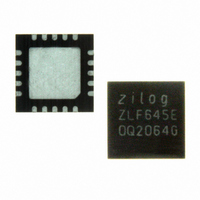ZLF645E0Q2064G Zilog, ZLF645E0Q2064G Datasheet - Page 92

ZLF645E0Q2064G
Manufacturer Part Number
ZLF645E0Q2064G
Description
IC MCU 64K FLASH 1K RAM 20-QFN
Manufacturer
Zilog
Series
Crimzon™ ZLFr
Specifications of ZLF645E0Q2064G
Core Processor
Z8 LXMC
Core Size
8-Bit
Speed
8MHz
Connectivity
UART/USART
Peripherals
Brown-out Detect/Reset, HLVD, POR, WDT
Number Of I /o
16
Program Memory Size
64KB (64K x 8)
Program Memory Type
FLASH
Ram Size
1K x 8
Voltage - Supply (vcc/vdd)
1.9 V ~ 3.6 V
Operating Temperature
0°C ~ 70°C
Package / Case
20-VQFN Exposed Pad, 20-HVQFN, 20-SQFN, 20-DHVQFN
Lead Free Status / RoHS Status
Lead free / RoHS Compliant
Eeprom Size
-
Data Converters
-
Oscillator Type
-
Other names
269-4723
Available stocks
Company
Part Number
Manufacturer
Quantity
Price
Company:
Part Number:
ZLF645E0Q2064G
Manufacturer:
Maxim
Quantity:
28
- Current page: 92 of 197
- Download datasheet (3Mb)
PS026407-0408
Note:
UART Interrupts
The UART is now configured for interrupt-driven data reception. When the UART
Receiver interrupt is detected, the associated ISR performs the following:
1. Checks the UART Status register to determine the source of the interrupt, whether it is
2. Reads the data from the UART Receive Data register, if the interrupt was caused by
3. Clears the UART receiver interrupt in the applicable Interrupt Request register.
4. Executes the IRET instruction to return from the ISR and await more data.
The UART features separate interrupts for the transmitter and the receiver. In addition,
when the UART primary functionality is disabled, the BRG can also function as a basic
timer with interrupt capability.
When the UART is set to run at higher baud rates, the UART receiver’s service routine
may not have enough time to read and manipulate all bits in the UART Status register
(especially bits generating error conditions) for a received byte before the next byte is
received. You can devise your own hand-shaking protocol to prevent the transmitter from
transmitting more data while current data is being serviced.
Transmitter Interrupts
The transmitter generates a single interrupt when the Transmit Status bit, UST[2], is set
to 1. This indicates that the transmitter is ready to accept new data for transmission. The
Transmit Status interrupt occurs after the internal transmit shift register has shifted the first
bit of data out. At this point, the Transmit Data register can be written with the next char-
acter to send. This provides 7 bit periods of latency to load the Transmit Data register
before the transmit shift register completes shifting the current character. Writing to the
UART Transmit Data register clears the UST[2] bit to 0. The interrupt is cleared by
writing a 0 to the Transmit Data register.
Receiver Interrupts
The receiver generates an interrupt when any of the following occurs:
•
•
an error, break, or received data.
data available.
A data byte is received and available in the UART Receive Data register—This
interrupt can be disabled independent of the other receiver interrupt sources. The
received data interrupt occurs once the receive character has been received and placed
in the Receive Data register. Software must respond to this received data available
condition before the next character is completely received to avoid an overrun error.
The interrupt is cleared by reading from the UART Receive Data register.
A break is received—A break is detected when a 0 is sent to the receiver for the full
byte plus the parity and stop bits. After a break is detected, it will interrupt
ZLF645 Series Flash MCUs
Product Specification
Operation
84
Related parts for ZLF645E0Q2064G
Image
Part Number
Description
Manufacturer
Datasheet
Request
R

Part Number:
Description:
Microcontrollers (MCU) Zlf645 (32K 20L Ssop F645 (32K 20L Ssop )
Manufacturer:
Maxim Integrated Products

Part Number:
Description:
Microcontrollers (MCU) Crimzon Flash Infrared MCU
Manufacturer:
Maxim Integrated Products

Part Number:
Description:
Microcontrollers (MCU) Crimzon Flash Infrared MCU
Manufacturer:
Maxim Integrated Products

Part Number:
Description:
Microcontrollers (MCU) Crimzon Flash Infrared MCU
Manufacturer:
Maxim Integrated Products

Part Number:
Description:
Microcontrollers (MCU) Crimzon Flash Infrared MCU
Manufacturer:
Maxim Integrated Products

Part Number:
Description:
Microcontrollers (MCU) Crimzon Flash Infrared MCU
Manufacturer:
Maxim Integrated Products

Part Number:
Description:
Microcontrollers (MCU) Crimzon Flash Infrared MCU
Manufacturer:
Maxim Integrated Products

Part Number:
Description:
Microcontrollers (MCU) Crimzon Flash Infrared MCU
Manufacturer:
Maxim Integrated Products

Part Number:
Description:
Microcontrollers (MCU) Crimzon Flash Infrared MCU
Manufacturer:
Maxim Integrated Products

Part Number:
Description:
Microcontrollers (MCU) Crimzon Flash Infrared MCU
Manufacturer:
Maxim Integrated Products

Part Number:
Description:
Microcontrollers (MCU) Crimzon Flash Infrared MCU
Manufacturer:
Maxim Integrated Products

Part Number:
Description:
Microcontrollers (MCU) Crimzon Flash Infrared MCU
Manufacturer:
Maxim Integrated Products

Part Number:
Description:
Microcontrollers (MCU) Crimzon Flash Infrared MCU
Manufacturer:
Maxim Integrated Products

Part Number:
Description:
Microcontrollers (MCU) Crimzon Flash Infrared MCU
Manufacturer:
Maxim Integrated Products

Part Number:
Description:
Microcontrollers (MCU) Crimzon Flash Infrared MCU
Manufacturer:
Maxim Integrated Products











